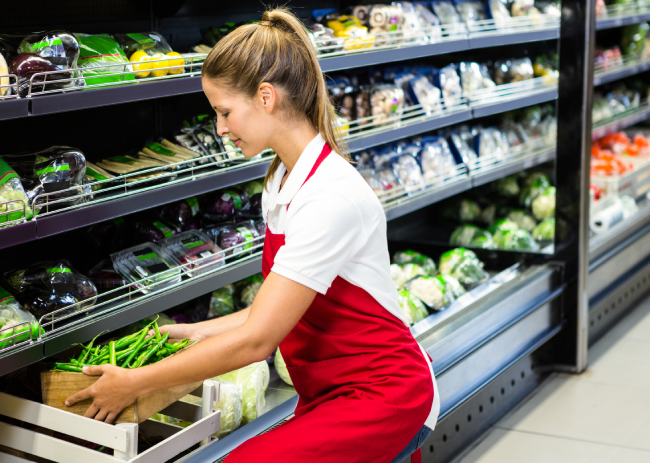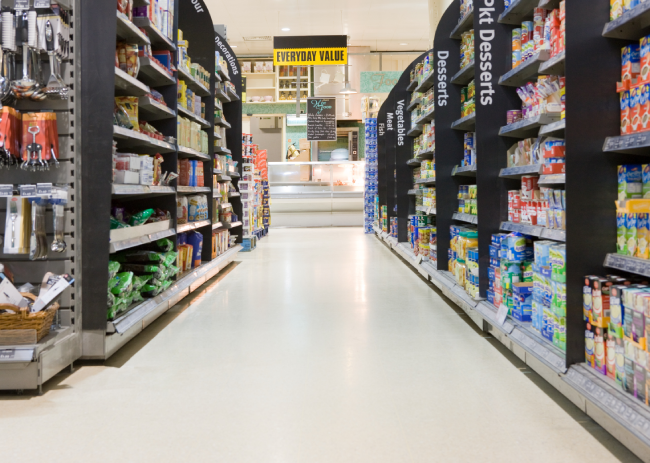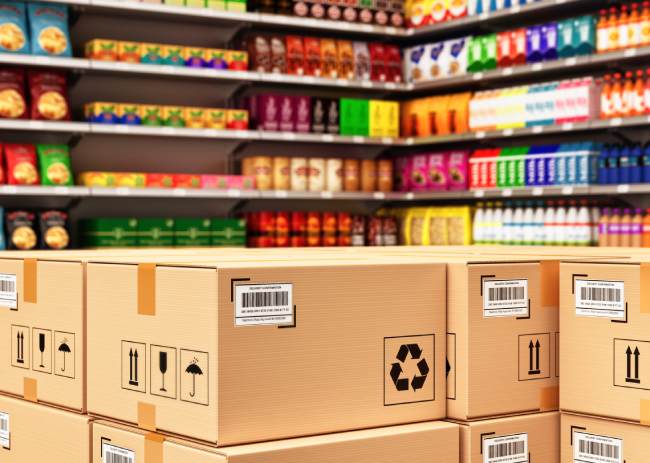The Ultimate Guide to Opening a Profitable Indian Supermarket
Are you considering opening a supermarket in India? The process of setting up an Indian supermarket can be relatively easy if you have the money, however, to succeed will be a whole different story.
The right product and the right price must be available at the right time, to the right people, in order for an Indian supermarket to succeed.
The term supermarket refers to a general retail store that sells various products for residential use, including domestic products such as household items, food products, drinks, daily need items, stationery, etc., all under one roof.
An Indian supermarket offers a wide selection of products laid out on slabs in sections that prospective buyers can see and choose from, as opposed to the general store you’ll find on nearly any street corner.
Furthermore, these supermarkets offer attractive discounts on products and operate on a large scale to bolster sales.
What is an Indian Supermarket?
The self-service shop that offers a wide assortment of household goods, food items, and cosmetic products is called a supermarket.
Indian supermarket gives shoppers/customers the chance to inspect the goods before making their purchase.
You can purchase both national and international brands under one roof at the most competitive prices.
Self-service supermarkets have the advantage that they reduce the need for labour costs for the owner.
In addition to a large variety of products at cost-effective prices, the supermarket offers attractive discounts, resulting in an exceptional turnover.
Indian supermarket makes shopping convenient and fast since they have well-organised, well-categorised products with proper billing counters.
In consideration of the convenience of customers, different payment methods are available at the Indian supermarket.
As a bonus, buyers receive a reward card.
Each time the buyer makes a purchase, they receive points.
They can then use these points to receive discounts or cashback.
The Indian supermarket has seen tremendous growth on small, medium and large scales over the last two decades.
Most customers, especially those in big cities and those who work full time, have limited shopping time, and when they do get the chance, they like to find all the products of their needs in one location.
Traditional general stores often focus on specific products, but supermarkets provide a wide assortment that anyone may need for general purposes.
The supermarket’s simple concept of bringing all necessary items together under one roof has allowed customers a hassle-free shopping experience, and its reach is expanding daily in India.
Benefits of an Indian Supermarket
The multiple benefits of an Indian supermarket are as follows:
#1. There is a self-service aspect to it
It is the customers’ responsibility to choose their own goods at the supermarket.
The trolleys, hand baskets, and bags provided to customers will enable them to store the goods they wish to buy while browsing other products.
For a store to succeed, it is essential to arrange the items systematically and display them beautifully.
It allows customers to select the goods more flexibly, thus increasing their satisfaction. This type of freedom is better suited to those customers who are not enthusiastic about seller interference.
Typically, the customer selects the goods and keeps them in their trolley.
Last but not least, they must make their payments in the billing section and take the products home.
#2. A credit extension is not available to customers
Cash and carry is the selling model used by supermarkets. Generally, these types of businesses do not offer credit facilities. The result is a reduction in bad debts.
#3. It is essential to provide a minimum level of service to customers
Customer service assistants at supermarkets often assist customers with finding the items they need, replenishing items when they run out of stock, helping customers check out, loading purchases into their vehicles, maintaining the store, and gathering shopping carts in the parking lot.
Furthermore, they can handle customer returns and interact with management and floor workers as needed to deal with complaints and requests.
#4. A no-bargain policy
In contrast to stores that typically require bargaining, supermarkets have always-fixed prices, which eliminates the need for a bargain.
#5. It is appealing to display the goods neatly
People shop offline primarily for the purpose of seeing the products in person.
Making store shelves more organised will increase purchases by customers, as it makes shopping more convenient.
In addition to the shelves, supermarket display racks must take advantage of the store layout by placing products in such a way that it facilitates more purchases.
Each item must be placed in such a way that it attracts shoppers’ attention and encourages them to purchase more.
#6. Areas with a high population density have supermarkets
The location of an Indian supermarket is usually in a place with ample space, like a central location. A large property houses the facility.
Such space is essential for displaying different types of products well.
#7. Purchasers benefit from quality goods at lower costs
The higher sales volume and low-profit margin of supermarkets enable them to offer quality brands at lower prices.
As supermarkets buy in bulk, they have relatively low prices for the items they sell.
They take less profit from customers because operating costs are lower.
So, both rich and poor people can benefit from these supermarkets.
#8. A wide array of products is available to customers
Shoppers at supermarkets have complete freedom of choice. The absence of salespeople in these supermarkets leads to customers choosing the products they want.
Supermarkets offer almost all the necessary goods for daily requirements under one roof, making them ideal for the average person. Generally, customers feel like they are paying a reasonable price for the correct quantity of the apt goods.
In this way, consumers do not need to move from one location to another to make their purchases.
#9. It’s convenient to shop
By offering many products under one roof, supermarkets facilitate easy and quick shopping.
It saves customers the time and effort of visiting several different shops to get all of their necessities.
#10. Bad debts are unlikely to happen
Because supermarkets use cash basis transactions, they don’t have to worry about bad debt.
#11. Supermarkets have a high turnover
The location of supermarkets is usually in a crowded area where they can draw a considerable customer base.
Buying in large quantities and selling out in small ones can provide them with the potential to earn a more substantial profit.
Furthermore, they bear only a limited amount of operating expenses and provide few free services to consumers. Profits increase automatically as a result.
The supermarket provides commodities needed on a regular basis.
In this way, they offer tinned products of reputable brands, groceries and provisions, ready-made garments, and fruits, among other things. Due to the ever-increasing demand for the necessities of life, turnover is quick.
Compared to around 17% gross margin in developed markets, Indian food and grocery retailers have around 14% gross margin.
#12. Low operational costs
Operating expenses for supermarkets tend to be low.
After-sales support is not available to their customers. Because of this, operating expenses are relatively low in comparison to departmental stores.
In supermarkets, customers do not receive free services, except for some nominal.
Their goal is to provide goods to customers at a lower price. Therefore, they employ a minimal number of sellers. Because of their absence of sales representatives and sales assistants, their salary bill is low.
As a result, supermarkets have lower operating costs.
#13. Large-scale operations have many advantages
Through their distinctive features, supermarkets can draw more customers.
Customers flock to supermarkets because of the low prices and extensive product selection.
Consequently, supermarkets can sell large amounts of goods quickly.
Evolution of Supermarkets in India
The majority of food products and FMCG goods were traditionally sold in India by independent stores and family-owned businesses in rural areas, neighbourhoods, and urban cities.
Kirana stores serve as the country’s largest food retailers that offer packaged foods, toiletries, eggs, bread, as well as ice cream that may be kept in small freezers.
Due to low labour, overhead, and real estate costs, store owners kept operational costs to a minimum (3-4% of turnover).
Unlike today, shopping was not always enjoyable. Many shops lacked basic amenities, such as air conditioning, were located on busy streets, and sometimes didn’t even have sidewalks, so shoppers would encounter difficulty walking when it was raining.
Small shops often have products stacked high to the ceiling, and as a result, customers will need to rely on the shopkeeper or their helper to locate the item they need.
Following the increased availability of branded consumer food products, retailers began upgrading stores, offering telephone ordering, and delivering food directly to consumers’ homes.
Delhiites could find a wide assortment of reasonably priced goods in Connaught Place, including everything from vegetables to transistors, when Super Bazaar opened in 1966.
Here, Super Bazar refers to “India’s first supermarket”.
In cities such as New Delhi, Bombay, Bangalore, Calcutta and Chennai, you could find supermarkets and convenience stores.
The idea of an Indian supermarket was relatively recent, somewhat like the small early American and European superstores. Compared to the traditional grocery stores in India, the convenience store was much larger but with fewer amenities than modern (but far fewer) supermarkets.
In the beginning, supermarkets failed to appeal to consumers, as most chose to shop at their neighbourhood shops that were easy to reach without transportation and sold similar products.
Since supermarkets offer more amenities, consumers naturally assumed that products would cost more there.
For the large, organised retailers, the initial strategy was to convince consumers that their products were cheaper than the traditional retailers, especially in the food sector.
Initially, the retail sector experienced sluggish growth due to high real estate costs, modest sales, and high operating costs (10-15% of turnover).
To mitigate these hurdles, these giant retailers developed their own strategies and have now accelerated their growth.
In the following years, high-income consumers shifted their focus toward convenience, local entrepreneurs updated their pricing strategies, and foreign supermarkets made their way onto the market, resulting in the emergence of a growing number of large retail outlets.
Over the last two decades, the Indian supermarket has grown enormously and is still growing at an exponential rate.
Metropolitan areas have traditionally been the focus of supermarket chains. In recent years, it has expanded into smaller towns, state capitals, and even other cities.
In India, more than a dozen supermarket brands are operating on both the regional and national scales. As a result of their popularity, these stores have attracted investors from all across the country.
Most traditional Indian businesses are shifting to a retail business model similar to that of supermarket chains, where the products are of as high a quality as those offered by the best brands in India.
Furthermore, they provide discounts, relatively affordable products, hospitality, attentive service, and a return and exchange policy.
With the help of data mining and analytical tactics, Indian supermarket businesses have expanded their market reach and encouraged consumers to purchase more than they originally planned to buy.
These have greatly influenced and attracted middle-class Indian consumers who seek affordable quality products at good bargains.
Prerequisites for Opening an Indian Supermarket
The following will provide you with some valuable insights into how to start a supermarket in India if you plan to open one.
When it comes to starting a business that requires a substantial amount of upfront investment, there are several nuances that need attention.
As a result, if we don’t address these nuanced issues in the beginning, many problems arise in the following steps, and there is no turning back.
In light of this, it would be prudent to take a thorough look at the measures and then decide how best to approach these minor issues, which at a later stage may pose more severe problems.
#1. Selecting the Right Location
The location of a business directly impacts sales.
A suburban supermarket will likely not be successful in a rural area due to different public and consumption habits. Rather than going to a supermarket, they prefer to buy from a small shop.
Therefore, to determine the best location for a supermarket, a careful analysis of the market is necessary.
The decision you make here has eternal significance because once you’ve made it, you can’t change the store location if footfall is lower than expected due to geographical factors. In other words, it’s an important strategic decision with long-term implications.
You need to identify a site where a supermarket is likely to flourish and where leasing costs will likely be minimal. A business’s survival isn’t solely determined by its ability to increase sales but rather by improving its cost control.
The ideal location for supermarkets is in an area where residents can easily access them. The likelihood of more footfall and more sales is higher in populated residential areas or commercial areas.
Store locations heavily influence the footfall of a store. For example, it would not be difficult to establish a new store nearby if another existing supermarket in the region is well-established and well-loved by locals for many years now.
Identifying areas where there are currently no stores or communities in need of grocery stores in their local areas is another considered factor when choosing a site.
#2. Supermarket Layout Planning
A supermarket’s layout is crucial to its success.
Among the main profitability metrics in retail, the layout of stores significantly impacts profit per square foot.
Preventing losses due to pilferage and improper storage is another important aspect of store layout.
An appropriately laid out store layout can avoid such problems by incorporating suitable displays and storage guidelines.
Changing the layout of your store every week would be detrimental, so it must be a one-time decision.
The overall scheme remains the same in the end, even if you make slight adjustments here and there.
Ensure the layout is precise and easy to follow without causing confusion or discomfort to the customers.
A supermarket’s arrangement of items can attract customers because they contribute to its appearance.
Displaying all of the available products in their respective categories and importance levels is essential.
In the supermarket, the layout and design must make it easy for customers to find what they are looking for at a glance.
#3. Product Assortment
The product mix refers to the diverse selection of goods that a retailer stocks and sells; it is sometimes called the product assortment. Two components make it up:
1. Product breadth
It is the number of product lines a store offers. It refers to how diverse and extensive a product lineup is. Having a large inventory spread is considered to be an indicator of a retailer’s product breadth. For instance, DMart sells everything from diapers and toilet paper to bedsheets and clothing.
2. Product depth
It refers to the range of variations within a specific product line. The emphasis here is on the size of an assortment within a particular category. The majority of speciality retailers offer a wide range of products. An office supply store, for example, may stock the same type of pen in several different colours.
One of the most necessary and challenging aspects of retail is creating the right product assortment.
Choosing the right merchandise mix involves both art and science.
Foresight and intuition into what a customer wants are important, along with data and a deep understanding of your customers and trends.
#4. Retail Merchandising
Merchandising is the art of preparing and displaying merchandise for sale in stores by brands, retailers, and other companies.
When it comes to retail merchandising, the process involves execution, such as the creation of shelves and installation of displays, as well as strategies, such as product placement and display design.
The objective of retail merchandising is to encourage shoppers to make a purchase.
Effective retail merchandising requires diligent planning, implementation, management, and analysis.
The art of retail merchandising is subtle.
The sensory experience is not something customers think about consciously when they enter the store.
In ways that even the purchaser might not be aware of, colours, sounds, smells, temperatures, and feel affect a purchaser’s buying decisions.
Art and science both go into retail merchandising.
Due to the importance of the retail industry and its growth, it has been the subject of extensive customer research that provides retailers with insightful merchandise strategies and best practices.
#5. Smart Pricing
Pricing stays at the top of mind for most supermarkets as they strive to increase traffic and sales.
Changing prices can be a strategic move to address changing demand and margin requirements as well as market conditions.
The technique of demand-based pricing in retail sometimes called smart pricing, helps retailers maximise sales and customer traffic.
#6. Stock Management
So that your customers aren’t disappointed when your items are unavailable, you must make sure that your supermarket has all the items in stock.
You can choose to have grocery items only, along with perishables, clothes, appliances, etc., in your supermarket based on your opinion.
Whichever category you choose, be sure to include all the items in that category.
Aside from the diversity of goods you acquire, you should also consider the quantity you purchase.
It is imperative to keep enough stock to avoid a stock-out situation.
Set up a reordering system and keep your stock levels at a very efficient level.
An overabundance of stocking will also cause losses due to expiration dates and accidental damages.
Everyday Cycle of an Indian Supermarket
#1. Recruitment
The basic idea behind a supermarket is that customers walk into the store, choose what they want, and leave with their purchases billed.
Nevertheless, you should also offer the fastest and most efficient services to ensure the satisfaction of clients.
For customers, it may be hard to find the items they need, those items do not necessarily have price tags, and those items are not always easily accessible.
To meet all these requirements, you must have a customer service team that is always on their toes to provide prompt service.
It is more important to have a billing service. It should not take long for customers to be freed at the billing counter. Keep several counters on hand to guarantee there is no delay during rush-hour traffic.
Make sure you hire knowledgeable and efficient personnel for billing purposes so they can streamline the billing process and do it promptly without error.
Your supermarket has several important positions, including accountants, cashiers, marketing managers, a store head, general workers, cleaning staff, and salespeople.
#2. Training and Retention
If you have recently hired several new staff members, you should take the time to learn more about each one so that you can determine which training method is best for them.
When training your employees, use a variety of learning methods so that they can grasp the information.
For instance, if you’re training the staff on how to use your inventory system or POS, show them how to use them live on-site and refer them to videos with how-tos they can reference at any time.
Or, if you require them to practice customer service, you can verbally instruct them about company policies, reinforce the information with handouts or videos, and then allow them to roleplay what they have just learned.
The battle for retail employees does not end with hiring them. For your organisation to truly grow and prosper, you must hire employees who are likely to stay at the company for a long time.
Unfortunately, individuals seeking short-term employment tend to fill retail positions.
This type of employee may serve a purpose, but if you hire only those who have no intention of growing with your company, then you may find yourself constantly starting the recruitment process – which can be a time and money drain.
You should instead develop a retention plan so that you can increase the percentage of employees who remain with your business.
To achieve this, you should learn the details about your employees and understand their needs.
It takes a team to accomplish retail work. You need to create an environment in which your employees feel safe and supported if you want them to stay.
#3. Day-to-Day Security Loss and Prevention
Loss prevention involves measures taken by businesses to decrease theft and fraud. Human error or deliberate actions can cause these preventable losses, called “shrinkage.”
Loss prevention refers to any measure that a company takes to reduce its loss risk. By limiting avoidable losses, loss prevention works to preserve profits.
In retail loss prevention, the goal is to identify the causes of shrinkage and implement effective solutions.
The purpose of hiring loss prevention managers and installing security cameras is to increase profits and reduce losses.
The higher your shrinkage, the harder it’s going to be for you to stay in business.
Reducing loss can lead to a number of unexpected benefits, such as better training for employees, better security measures, and more effective customer service.
#4. Customer Relationship Management
Using customer relationship management (CRM) in your supermarket can boost sales, revenue, and profitability. It can help you maintain relationships with your customers and foster a positive experience.
In addition to improving lead conversion, client retention, and client satisfaction, customer relationship management can also reduce attrition rates and time spent on establishing new strategies.
Customers’ positive experiences can have the effect of justifying price increases in their minds.
Marketing an Indian Supermarket
Marketing and publicity are more significant than merely establishing the supermarket to let people know of your existence.
Managing marketing should involve developing promotional strategies and maximising sales.
Marketers should not solely be concerned with publicising or promoting any particular brand but instead with communicating the supermarket’s products to customers.
Word-of-mouth drives most of the growth of such businesses.
If a customer leaves your store satisfied, he will spread the word to his circle.
This kind of faith and trust is vital to the success of any business, and it is more powerful than paid advertising.
Discounts and offers are two ways of promoting.
Embrace sensible marketing ideas to avoid potential problems later.
Don’t announce any offers until you’ve considered your financial capacity.
Every time you adopt a new marketing idea, create new promotional materials.
With memberships, you can build a database of potential customers that you can use to make future profits.
You should establish a strategic relationship with major brands and provide products at exclusive prices exclusively available at your supermarket.
To succeed in your market, you need to remain informed of new products and demand.
Money Matters: Reports, Costs, Budgets and Profits
#1. The Costs of Running an Indian Supermarket
Investment has a significant impact on both the efficiency of a business and its size.
Therefore, accurate and precise forecasting of how much investment will be required to meet the company’s needs in the future is necessary.
Your supermarket should ideally be able to run with the number of resources you have.
In the absence of sufficient cash, you will have difficulty operating the business.
Maintain at least a quarter of the total investment as a reserve for further operations.
The reason is that you will be responsible for dealing with fluctuations in business yourself.
To invest in this business, you need to consider the following 5 factors:
- Cost of renting or leasing a proper location for your business.
- Initial setup costs, such as layout, and racks.
- Purchase of stock items.
- Costs associated with setting up a business, such as licensing requirements.
- Technology investments such as CCTV, a billing desk, and billing software.
An investment of approximately 50 lakhs is required in India to start a mini supermarket (1000 square feet).
Business expansion in the future is a decision you have to make based on more funds or profits.
The estimation is for a business operating at a medium scale with minimal facilities.
Investing a crore of rupees in a big supermarket is definitely possible if you’re comfortable handling the financial aspects.
You will need an accountant who understands what’s happening with all the transactions and maintains all the records.
The company needs to conduct regular audits to monitor progress and determine improvement areas.
By analysing the first year’s transactions, you can estimate the profits and costs incurred.
#2. Key Performance Indicators
Your business should be measuring KPIs often, or a technical term called “key performance indicators.”
Keeping an eye on these numbers will allow you to judge if your business is on the right track.
1. Sales per square foot
This metric allows you to calculate the number of sales per square foot of retail space.
Using the following formula, you can find out your sales per square foot:
net sales/amount of sales space
Retail sales per square foot increase when a store is more productive.
It can also give you an estimate of how well your shop is utilising space and fixtures.
Plan your store layout and merchandise based on this metric.
2. Sales per employee
When you’re planning out your team’s schedules and initiatives, you can use sales per employee as a metric.
The following equation makes it easy to measure:
net sales/number of employees
You can use this metric to make more intelligent employment decisions, particularly when determining the rostering process and compensating your employees.
3. Conversion rate
Conversion rate is defined as the ratio of the number of store visits to the number of completed purchases.
For calculation, use this formula:
number of sales / total number of visitors
How well you convert potential buyers into buyers can be gauged by your conversion rate.
Driving store traffic is a good thing, but if your visitors aren’t converting, the traffic won’t make any difference to your bottom line.
4. Stock turnover
Known as inventory turnover, this metric represents the number of times a given amount of stock is used, sold, and consumed in a specified period.
Here is the formula for calculating it:
cost of goods sold / average inventory
Stock turn serves as a crucial metric to determine your optimal inventory level.
When you have a low stock turn, this means you aren’t able to sell out of inventory fast enough, putting you at risk of carrying slow or dead stocks.
#3. Automation
Keeping supermarkets competitive will largely depend on how they utilise automation.
To do this, they will increase productivity in three areas:
- Labour: Reducing the number of hours of work required to produce the same amount of sales.
- Inventory: Enables retailers to replenish their stores with individual items rather than case quantities.
- Space: Dynamically adjust display space to better match sale patterns within a week or even by day.
Increasing automation has the potential to attract more educated and productive workers into the food retailing sector.
As automation increases, supermarkets will become more desirable places to work, changing their perception of themselves.
“Self-service” retailing will be reduced/replaced by automated order selection systems as they optimise order fulfilment.
In addition to eliminating the need for human workers to fill orders from the aisles, auto fulfilment systems also free up shoppers from having to travel up and down aisles searching for shelf-stable products.
With the help of automation, grocery shopping experiences will dramatically improve, allowing customers to create customised versions of the store to suit their personal preferences.
#4. Reports
You need to know what is happening in your business with the use of reporting and analytics.
Data analysis is critical when it comes to making informed decisions about stock orders, promotions, and staffing, among other things.
1. Inventory on hand
This report should always be run on a regular basis so that you will always know how much merchandise you have in your stores.
2. Low Stock
An out-of-stock situation is never acceptable in retail.
Aside from leading to lost sales, out-of-stocks also cause customer dissatisfaction and send customers to your competition.
3. Product Performance Report
Reports like this should summarise the amount of merchandise you’ve sold over a given period as well as a breakdown of items sold per month or per week.
4. Sales Summary
The report gives you a comprehensive view of your sales over a given timeframe.
You should also record your cost of goods sold, gross profit, margins, and taxes on your sales report so you can understand how much money remains for your business.
#5. Licenses and permissions
Obtaining legal documents is imperative for any business to succeed in the market and appear in government directories.
The purpose of it is to recognise your business and categorise it under the proper headings.
You can never go wrong when you run a legal business because you possess valid documents.
1. Property registration
You must acquire a lease or contract if you plan on operating your business on another person’s land or property.
Rent Control Act oversees the implementation and enforcement of this contract.
The terms and conditions of a residential rental agreement or lease contract differ significantly from what you have to obtain for a commercial purpose.
The contract should specify work hours, maintenance needs, and other details.
2. Trade license
You must obtain a trade license from the municipality as the owner of the business.
Any business that wants to operate in the market needs to have a trade license, regardless of its purpose.
It is to evaluate your business from ethics, safety, standard, and regulatory perspective.
Local municipal authorities usually issue trade licenses within eight days of your application.
If you fail to submit the required documents, the period may extend.
3. License from FSSAI
Obtaining an FSSAI license is mandatory if you sell food items in your supermarket.
The Food Safety and Standard Authority of India considers any business that sells food products to be part of the food business category.
You will need a Central license for your supermarket headquarters if you have multiple outlets.
In the case of non-renewal, an FSSAI license is void after five years.
4. GST Registration
All businesses must adhere to the Goods and Services Tax as it is an inevitable taxation norm.
The GST pin for your supermarket should be 15-digits, which you will receive after you register your store.
Growth and Expansion
#1. Add home delivery option
Today, people are either lazy or have no time to go to stores to shop.
Providing home delivery services for certain items is always an option.
For transporting such goods, it may be necessary to use a bicycle or car.
You can decide whether to deliver free of charge or at a cost based on your profits and losses.
The most important thing is that your supermarket ought to be not only rich in infrastructure and products, but also very responsive to customers’ needs.
Customers appreciate a store that treats them as valued guests and will accommodate their requests with patience and courtesy.
The most important thing to remember is to always look at your steps from the perspective of whether or not they will lead to profit or loss.
#2. E-Commerce
Businesses like online grocery stores, which are taking advantage of the growing online market, are making E-commerce more reputable and promising.
An online grocery store represents an incredible investment opportunity and will make you the boss of your business.
Online businesses are an excellent way for young and potential businessmen to invest their money since the risks of loss are low when they are done small scale, meaning in the beginning stages where the business slowly and steadily gives a profit.
You can only achieve success when you are willing to invest your time and money.
Online business offers an edge as well because you don’t need a big office or a lot of furniture to start up, just products, a way for customers to access them, and an e-commerce system for delivering them.
FAQs:
What is a supermarket in India?
Food and household goods are the main products available in Indian supermarkets.
Besides grocery items, Indian supermarkets offer other important items such as clothes, home furnishing items, toiletries, durables, electronic appliances, and many more.
Consumers can inspect the goods in an Indian supermarket before buying them.
At the most competitive prices, both national and international brands are available under one roof.
Owning a self-service supermarket reduces labour costs for the owner due to its convenience.
Furthermore, the supermarket offers attractive discounts, resulting in exceptional sales.
With their well-organised, well-categorised products and proper billing counters, Indian supermarkets make shopping both convenient and fast.
Indian supermarkets offer a variety of payment options to maximise convenience for customers.
What should I buy from an Indian supermarket?
Indian supermarket sells grocery items, fresh produce, apparel, electronics, consumer durables, etc.
In addition to food, they sell wellness and beauty products, as well as spiritual herbs and spices.
Every supermarket stocks the following items:
– A general selection of common eatable items
– Trendy snacks and soft drinks
– Cosmetics such as creams, moisturizers, combs, etc.
– Bathroom products such as soap, shampoo, face wash, detergent powders, etc.
– Besides tea, there is coffee and sauce.
– Household cleaning products required in the kitchen, bedrooms, and bathrooms
– Packaged and unpackaged meat products
– Almost everything a baby needs can be found among baby care products
– Men’s, women’s, and children’s clothing, including the latest fashions
– Decorative items, cooking utensils, and housewares.
– Irons, microwaves, TV fridges, and other electronic items for domestic use.
– Home furnishings
– Grooming items, hygiene items, cosmetics, etc.
Furthermore, an individual can have items that are specially selected, based on their needs.
Do they have supermarkets in India?
Indian cities are awash in supermarkets, a testament to how modernized the country’s retail industry has become; however, small shops called Kirana still attract customers.
Modern retail will control over 6% of the food & grocery market by 2024 with a compound annual growth rate (CAGR) of 16%.
There are now more opportunities for entry into organised retail than ever before, and this trend is becoming more widespread across the country.
Organised retail is enabling retailers to offer a wide range of products in more optimised spaces – a benefit of realigning business models.
It has even taken hold in Tier 2 cities in India, which normally signal a boom because these small urban centres have high population densities.
Which is the biggest supermarket chain in the world?
Walmart remains the biggest retailer globally both domestically and internationally, even as Amazon’s popularity is growing.
Walmart also achieved the highest overall rating in the Top 50 ranking.
Nonetheless, it is facing challenges from Amazon, Alibaba, and newcomer JD.com, which already has massive gross merchandise volume.
With the recent shifts in Walmart’s business model, it has built a more robust omnichannel approach to expand its marketplace platforms and services.
Even after divesting from a number of markets, it still ranks in the top five of the international retailer rankings.
Brazil was first, followed by the United Kingdom, and recently Argentina and Japan made the list. There is a good chance that it will remain No. 1 in the next Top 50 with a smaller lead.
Why do they call it a supermarket?
Chain stores, also known as supermarkets, are typically supplied by the distribution centres of their parent companies, providing a more cost-effective and efficient way of shopping.
As a result of their bulk buying power, supermarkets can often find goods at lower prices than smaller stores and offer them at relatively low prices.
Food, beverages, and household products can be found in several sections of a supermarket, which is a self-service store.
The use of shopping carts (trolleys) or baskets assists with labour cost reduction, and many supermarket chains are switching to self-serve checkout to further reduce labour costs.
The range of merchandise is smaller and less extensive than a hypermarket, but it is larger and has a larger selection than earlier grocery stores.
Which is bigger a supermarket vs a hypermarket?
Supermarkets are large stores, but hypermarkets are much bigger.
Compared to supermarkets, hypermarkets store more FMCG products.
Unlike a hypermarket, which often looks like a warehouse, a supermarket has a warm, welcoming appearance that attracts customers.
It is also more appealing to shop at a Supermarket than at a Hypermarket.
A supermarket offers more personalised services and a warm approach that is not provided at a hypermarket.
Hypermarkets generally offer lower prices than supermarkets.
Festivals are a time for redecorating Supermarkets and introducing fun activities in addition to the traditional products, which aren’t seen at hypermarkets.
The Takeaway
Indians are a very consumer-oriented country with a large population and booming economy.
They are ready to spend money on products they need on a daily basis.
Your chances of success are plentiful, just be focused on your customers, invest in better infrastructure, and improve technology to make the most of your upcoming business.
Ready to start your Indian Supermarket? Tell us how you’re going to do it in the comments section below!
Dhruvi is a bubbly, affable person and a reading enthusiast. She would never set foot in the kitchen if not for an easy and exciting recipe.



















I’m not sure if I’ve ever left a comment before, but I’ve always like your blog and find myself returning to it time and time again for inspiration. Beautiful cuisine, and even more beautiful photographs. Continue to do excellent work and to post regularly. Wishing you the best!